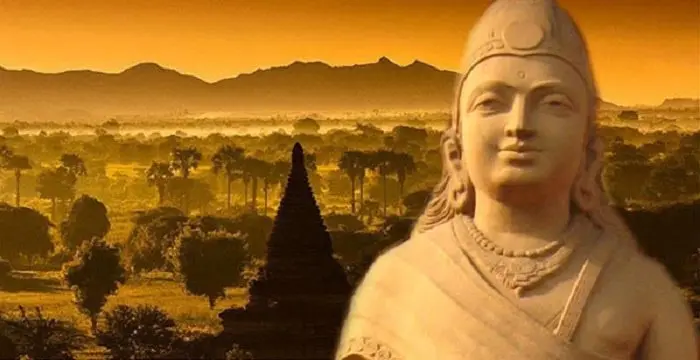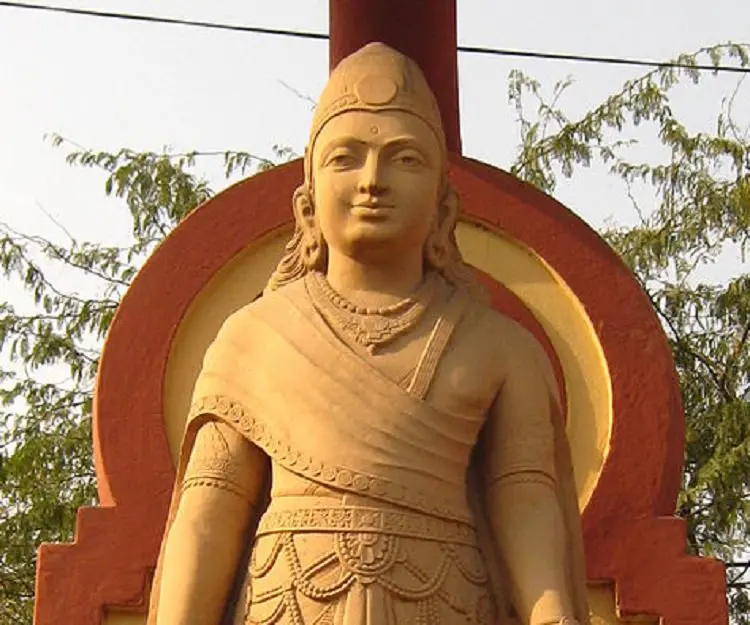
Chandragupta Maurya - Founder of the Maurya Empire, Timeline and Life
Chandragupta Maurya's Personal Details
Chandragupta Maurya was the founder of the Mauryan Empire and is credited for unifying India for the first time in history
| Information | Detail |
|---|---|
| Birthday | 340 BC |
| Nationality | Indian |
| Famous | Historical Personalities, Emperors & Kings, Emperors, Founder of the Maurya Empire, Kings |
| Spouses | Durdhara |
| Childrens | Bindusara |
| Founder / Co-Founder |
|
| Birth Place | Pataliputra |
| Religion | Hinduism, Jainism |
| Gender | Male |
| Father | Sarvarthasiddhi Maurya |
| Mother | Mura Maurya |
| Born in | Pataliputra |
| Famous as | Founder of the Maurya Empire |
| Died at Age | 42 |
// Famous Kings
Sundiata Keita
Sundiata Keita was the founder of the Mali Empire in West Africa. This biography profiles his childhood, early life, struggles, founding of empire, rule, administration, achievements and also gives some fun facts.
Ashoka
Ashoka was the third emperor of the Mauryan Dynasty and ruled almost the entire Indian subcontinent. This biography profiles his childhood, life, reign, achievements and timeline
Murad IV
Murad IV was one of the mighty Sultans in the history of the Ottoman Empire. This biography profiles his childhood, family, accession, rule, administration and timeline.
Chandragupta Maurya's photo
Who is Chandragupta Maurya?
Chandragupta Maurya, who founded the Maurya Empire, was one of the most important rulers in the history of India. He is credited for unifying small independent states to form a large single kingdom for the first time under one administration, leaving aside Kalinga and the Tamil regions of Chera, Chola, Satyaputra, and Pandya. He was successful in destroying the Nanda dynasty, which ruled most of northern India, at the young age of 20. Along with his chief advisor and Brahmin scholar, Chanakya, he seized the Macedonian territories and conquered the eastern territories of Alexander’s general Seleucus to add them to his empire. His empire stretched across Kashmir in the north to Deccan Plateau in the south and Afghanistan and Balochistan in the west to Bengal and Assam in the east. Nevertheless, he voluntarily left his throne and accepted Jainism, moving southwards to Karnataka. His grandson, Ashoka, followed his footsteps in completing the pending conquest of Kalinga and Tamil kingdom in 260 BC. While Ashoka was a highly cruel and fierce initially, Chandragupta, on the other hand, was far less bloodthirsty
Childhood & Early Life
Chandragupta Maurya was born in 340 BC in Pataliputra, in modern-day Bihar. His background is, however, uncertain. Some claim that he was born to a Nanda prince and his maid-servant, Mura, from the Shudra caste, while others state that he belonged to the Moriya tribe of Peacock-tamers.
Being a brave and determined leader since childhood, he was very well guided by Chanakya, a great Brahmin scholar of economics and political science at Takshashila University, who later became his mentor.
Accession & Reign
He raised an army with assistance from Chanakya, who went on to become his chief advisor and prime minister after establishing the Maurya Empire.
Chandragupta was able to overcome the Nanda army after a series of battles and finally laid siege of Patliputra, the capital city. The conquest of the Nanda Empire enabled him to lay the foundation of the Maurya Empire in North India at the young age of 20
After Alexander’s death in 323 BC, his empire was divided into three satrapies among his generals, with the Macedonian territories, including Punjab, falling under the control of Seleucus I Nicator.
Since Seleucus was busy on the western borders, Chandragupta took this opportunity to attack and assassinate two Macedonian satrapies, Nicanor of Parthia and Philip, son of Machatas.
After defeating Seleucus, Chandragupta signed a peace treaty with him, according to which he got hold of Punjab in exchange of 500 war elephants.
With most of the northern parts of the Indian subcontinent under his rule, he moved southwards conquering independent Indian states in the Vindhya Range and Deccan Plateau by 300 BC.
While he succeeded in unifying most of the Indian subcontinent, he failed to annex Kalinga (modern-day Odisha) on the east coast and the Tamil kingdom on the southernmost tip, which was eventually done by his grandson, Ashoka.
According to Megasthenes and Strabo, he is believed to have raised an army of 400,000 soldiers, while Pliny reported the figure to be 600,000 foot-soldiers, 30,000 cavalry and 9,000 war elephants.
Major Battles
After a series of unsuccessful attempts, he defeated the forces of Dhana Nanda and his army commander, Bhadrasala, in 321 BC thereby ending the Nanda Dynasty and conquering its capital, Pataliputra.
With a view to further expand his empire, he set his eyes on eastern Persia and successfully invaded it in 305 BC, and captured areas including Hindu Kush, modern-day Afghanistan and Balochistan in Pakistan.
Achievements
By conquering most of the Indian subcontinent, he went on to establish one of the largest empires in Indian history, extending from Central Asia in the west to Burma in the east and Himalayas in the north to Deccan Plateau in the south.
Personal Life & Legacy
He married Seleucus’ daughter, which further enhanced his friendly relations with the Hellenistic kingdoms apart from improving India’s trade with the western world.
He abandoned his throne and converted to Jainism, eventually becoming a Muni under Shrutakevali Bhadrabahu with whom he traveled to Shravanabelagola (in modern Karnataka), where he meditated and fasted to death in 298 BC.
He was succeeded by his son, Bindusara, who was later succeeded by his grandson, Ashoka who became one of the most influential rulers of ancient India.
Trivia
His reign formed the base of Dr. Mysore N. Prakash’s historic/spiritual novel ‘The Courtesan and the Sadhu’.
His bonding with Chanakya was adapted into a 1977 Telugu film ‘Chanakya Chandragupta’. Famous Telugu actor Akkineni Nageswara Rao played the role of Chanakya, while another legendary Telugu actor N. T. Rama Rao portrayed as Chandragupta.
In 2011, a commemorative postage stamp was released by the Indian Postal Service in his honor.
TV series ‘Chanakya’ (based on the play Mudra Rakshasa) is an account of life and times of Chanakya.
// Famous Emperors
Sundiata Keita
Sundiata Keita was the founder of the Mali Empire in West Africa. This biography profiles his childhood, early life, struggles, founding of empire, rule, administration, achievements and also gives some fun facts.
Ashoka
Ashoka was the third emperor of the Mauryan Dynasty and ruled almost the entire Indian subcontinent. This biography profiles his childhood, life, reign, achievements and timeline
Murad IV
Murad IV was one of the mighty Sultans in the history of the Ottoman Empire. This biography profiles his childhood, family, accession, rule, administration and timeline.
Chandragupta Maurya biography timelines
- // 340 BCChandragupta Maurya was born in 340 BC in Pataliputra, in modern-day Bihar. His background is, however, uncertain. Some claim that he was born to a Nanda prince and his maid-servant, Mura, from the Shudra caste, while others state that he belonged to the Moriya tribe of Peacock-tamers.
- // 323 BCAfter Alexander’s death in 323 BC, his empire was divided into three satrapies among his generals, with the Macedonian territories, including Punjab, falling under the control of Seleucus I Nicator.
- // 321 BCAfter a series of unsuccessful attempts, he defeated the forces of Dhana Nanda and his army commander, Bhadrasala, in 321 BC thereby ending the Nanda Dynasty and conquering its capital, Pataliputra.
- // 305 BCWith a view to further expand his empire, he set his eyes on eastern Persia and successfully invaded it in 305 BC, and captured areas including Hindu Kush, modern-day Afghanistan and Balochistan in Pakistan.
- // 300 BCWith most of the northern parts of the Indian subcontinent under his rule, he moved southwards conquering independent Indian states in the Vindhya Range and Deccan Plateau by 300 BC.
- // 298 BCHe abandoned his throne and converted to Jainism, eventually becoming a Muni under Shrutakevali Bhadrabahu with whom he traveled to Shravanabelagola (in modern Karnataka), where he meditated and fasted to death in 298 BC.
// Famous Historical Personalities
Sundiata Keita
Sundiata Keita was the founder of the Mali Empire in West Africa. This biography profiles his childhood, early life, struggles, founding of empire, rule, administration, achievements and also gives some fun facts.
Ashoka
Ashoka was the third emperor of the Mauryan Dynasty and ruled almost the entire Indian subcontinent. This biography profiles his childhood, life, reign, achievements and timeline
Jetsun Pema
Jetsun Pema is the Queen consort of Bhutan. Check out this biography to know about her childhood, family life, achievements and fun facts about her life.
Murad IV
Murad IV was one of the mighty Sultans in the history of the Ottoman Empire. This biography profiles his childhood, family, accession, rule, administration and timeline.
Xerxes I
Xerxes I (Xerxes the Great) was the fourth and the most famous king of the Archaemenid dynasty of Persia. This biography profiles his childhood, family, personal life, life history, achievements, campaigns, administration, death and other facts.
Sargon of Akkad
Sargon of Akkad, also called ‘Sargon the Great’, ‘Sarru-Kan’ and ‘Shar-Gani-Sharri’, was the founder and first king of the Akkadian Empire. This biography profiles his childhood, life, rule, administration, timeline, and gives some fun facts.
Chandragupta Maurya's FAQ
When was Chandragupta Maurya died?
Chandragupta Maurya was died at 2020-04-14
Where was Chandragupta Maurya died?
Chandragupta Maurya was died in Shravanabelagola
Which age was Chandragupta Maurya died?
Chandragupta Maurya was died at age 42
Where is Chandragupta Maurya's birth place?
Chandragupta Maurya was born in Pataliputra
What is Chandragupta Maurya nationalities?
Chandragupta Maurya's nationalities is Indian
Who is Chandragupta Maurya spouses?
Chandragupta Maurya's spouses is Durdhara
Who is Chandragupta Maurya childrens?
Chandragupta Maurya's childrens is Bindusara
Which company or organization was founded by Chandragupta Maurya?
Chandragupta Maurya was the founder/co-founder of Maurya Empire
What is Chandragupta Maurya's religion?
Chandragupta Maurya's religion is Hinduism, Jainism
Who is Chandragupta Maurya's father?
Chandragupta Maurya's father is Sarvarthasiddhi Maurya
Who is Chandragupta Maurya's mother?
Chandragupta Maurya's mother is Mura Maurya
How famous is Chandragupta Maurya?
Chandragupta Maurya is famouse as Founder of the Maurya Empire







